Sustainable parking and mobility projects from 2018.
By Megan Leinart, LEED AP BD+C
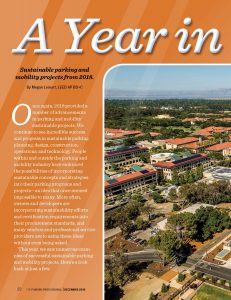
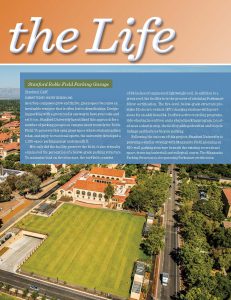
Once again, 2018 provided a number of advancements in parking and mobility sustainable projects. We continue to see incredible success and progress in sustainable parking planning, design, construction, operations, and technology. People within and outside the parking and mobility industry have embraced the possibilities of incorporating sustainable concepts and strategies into their parking programs and projects—an idea that once seemed impossible to many. More often, owners and developers are incorporating sustainability efforts and certification requirements into their procurement standards, and many vendors and professional service providers are to using these ideas without even being asked. This year, we saw numerous examples of successful sustainable parking and mobility projects. Here’s a look back at just a few.
Stanford Roble Field Parking Garage
Stanford, Calif.
SUBMITTED BY: WATRY DESIGN, INC.
As urban campuses grow and thrive, green space becomes an invaluable resource that is often lost to densification. Designing parking with a green roof is one way to have your cake and eat it too. Stanford University has utilized this approach for a number of parking garages on campus, most recently for Roble Field. To preserve this open grass space where students gather, relax, and enjoy recreational sports, the university developed a 1,162-space parking garage underneath it.
Not only did the facility preserve the field, it also virtually eliminated the perception of a below-grade parking structure. To minimize load on the structure, the turf field consists of 24 inches of engineered lightweight soil. In addition to a green roof, the facility is in the process of attaining Parksmart Silver certification. The five-level, below-grade structure provides 52 electric vehicle (EV) charging stations with provisions for an additional 84. It offers active recycling programs, ride-sharing incentives, and a shared parking program. Located near a shuttle stop, the facility adds pedestrian and bicycle linkage and features bicycle parking.
Following the success of this project, Stanford University is pursuing a similar strategy with Manzanita Field, planning an 850-stall parking structure beneath the existing recreational space, featuring basketball and volleyball courts. The Manzanita Parking Structure is also pursuing Parksmart certification.
Nashville International Airport Parking and Transportation Center
Nashville, Tenn.
SUBMITTED BY: WALKER CONSULTANTS
Due to the tremendous growth in passengers at Nashville International Airport (BNA), the Metropolitan Nashville Airport Authority (MNAA) is planning BNA Vision, a multi-year expansion program. One of the first projects under the program is the Parking and Transportation Center, which opened in November 2018. The center has 2,200 parking spaces and a ground transportation center on the bottom level for shuttles, buses, taxis, and transportation network companies. As with all projects at the airport, the Nashville Airport Experience (NAE), BNA’s customer service mantra, was the guiding principle during design. One of the primary considerations of NAE is sustainability.
The facility is pursuing Parksmart certification and has included several features that help meet this goal and improve the customer experience such as:
- EV charging stations.
- Tire inflation station.
- Recycling program.
- Internal and external automated parking guidance system.
- Idle-reduction payment systems.
Additionally, MNAA has included features that help reduce operating costs and meet the airport’s sustainable goals, including:
- Rainwater harvesting for irrigation.
- Water-efficient landscaping.
- Lighting system with daylight and occupancy sensor controls.
- Proactive operation maintenance program.
All of these features plus the additional measures taken during construction, such as regional materials and labor as well as a construction waste management program, have been integrated into the project to create a net positive impact both economically and environmentally.
New Jersey Institute of Technology
Parking Garage
Newark, N.J.
SUBMITTED BY: TIMOTHY HAAHS & ASSOCIATES, INC.
The New Jersey Institute of Technology (NJIT) recently completed a new 941-space parking structure on its campus in Newark, N.J. The facility is an infill project located on a previous parking lot.
The NJIT parking facility is pursuing Parksmart Bronze certification. Sustainable elements include:
- EV charging stations.
- Public green space for use of students, faculty, staff, and the community.
- Natural ventilation.
- Newark Light Rail one block away.
- Extensive sustainable purchasing program that includes paper, furniture, parking tags, and more.
- Vehicle-idle reduction systems.
- Sustainable maintenance and cleaning procedures.
- Energy efficient LED lighting.
- Native, water-efficient landscaping around the garage.
- Recycling program.
The garage will support the growing parking needs of the campus, serving students, faculty, and staff and accommodating future development plans. The parking structure is designed to support future installation of approximately 14,000 square feet of retail/flex space.
Pittsburgh Gold 1 Garage
Pittsburgh, Pa.
SUBMITTED BY: WTW ARCHITECTS
Located adjacent to nearby PNC Park (home of the Pittsburgh Pirates), Heinz Field (home of the Pittsburgh Steelers), and other entertainment and dining establishments, Pittsburgh’s Gold 1 Garage is the first garage to achieve Parksmart Gold certification. The design of this new-construction parking facility showcases the City of Pittsburgh’s sustainability goals and provides a convenient point of access to the popular area for daily, weekend, and event patrons.
Owned and operated by the Stadium Authority of the City of Pittsburgh, the six-level, 1,000-space garage reduced energy consumption by specifying the use of regional materials and diverting more than 85 percent of construction waste from landfills. The facility also includes a single-stream recycling program that encourages patrons to recycle cardboard, paper, glass, and aluminum.
The multi-modal facility is located in close proximity to a number of bus stops and light rail stations, encouraging more sustainable transportation options, and 4 percent of the garage spaces are reserved for fuel-efficient, carpool, or HOV ride-share vehicles. The garage also includes two DC fast-charging stations, a commuter shuttle program for local hospital employees, and 100 bike parking spaces along with a bike maintenance station and bike racks.
The garage features living walls made of native, drought-tolerant plants and perennial vines to harvest rainwater and direct it to screens and surrounding plant beds. Further, the owner included an educational program via large electronic LED displays in the lobby, highlighting sustainable features and fun facts about the garage, including the benefits of green wall plantings and the stormwater capture system.
Obiicev Venac Public Parking Garage
Belgrade, Serbia
SUBMITTED BY: ENERGO ENERGY EFFICIENCY ENGINEERING
The Obiicev Venac Public Parking Garage is located in the Central Zone of Belgrade, near the city’s downtown pedestrian zone. It is part of the public utility (Parking Servis) garage network, which manages 35,000 parking spaces serving the 2 million residents of Serbia’s capital city.
Due to its location in the city’s historical downtown, the architectural design complements the surrounding ambience, while managing to increase the number of parking spaces. In addition to meeting growing parking demand, goals of the project included extensive energy-efficient practices, minimizing the environmental impact, promoting sustainable transportation, and decreasing costs through efficient management.
Some of the innovative sustainability features include:
- Solar panels.
- EV charging stations.
- LED lighting.
- Recycling program.
- Natural ventilation of parking decks.
- Internal and external wayfinding signage.
- Free rental bicycles.
- Incentives for drivers of alternative-fuel vehicles.
- Renewable source generation plant (PV panels) .
- 92 percent of indoor lighting controlled by occupancy sensors.
- 98 percent of outdoor lighting controlled by programed timers.
The project also incorporated a number of successful community outreach features and programs, including:
- Installing a local meeting point with free Wi-Fi.
- Incorporating placemaking zones for exhibitions, educational, and cultural purposes.
- Allocating parking spaces for local residents and providing them with subsidized parking.
Originally constructed 40 years ago, the facility’s reconstruction has set a new standard for sustainable parking and transportation. In April 2018, Obilicev Venac achieved Parksmart Bronze certification, becoming the first garage in Europe to be awarded Parksmart certification. The application of Parksmart measures resulted in a 33 percent reduction in operation and maintenance costs.
Cal Poly Pomona
Pomona, Calif.
SUBMITTED BY: CAL POLY POMONA
Cal Poly Pomona’s second parking structure recently earned Parksmart Bronze certification. The 1,800-space parking facility includes a number of sustainable features, including:
- Solar panels.
- Wi-Fi.
- Secure bicycle storage.
- Automated, dimmable LED lighting.
- 24 EV charging stations.
- Ride-share parking.
The facility also serves as a stop for four university shuttles, one of which connects with local transit, allowing students to use alternative transportation to reach the campus.
Michael Biagi, university director of parking and transportation services, says, “It’s the best parking on campus by far. It provides the quickest shuttle service to the center of campus, and I think it will provide the best parking experience for our students. The sustainable features of this structure really have our students excited about what can be done with sustainable design.” Biagi highlighted the drought-tolerant landscaping and state-of-the-art rainwater collection system as two of the features that demonstrate the university’s commitment to protecting the environment.
The $41 million structure was built on the site of a surface parking lot, and university officials went to great lengths throughout the process to ensure that the construction and operation of the structure was as sustainable as possible. The contractor used locally sourced concrete, recycled asphalt to pave the surface lot, and hired local labor to shorten workers’ commutes.
Main Street Cupertino Loft Residences Garage
Cupertino, Calif.
SUBMITTED BY: NAGLE ENERGY SOLUTIONS
Developed by Sand Hill Property Company, Main Street Cupertino Lofts is part of a newly created, mixed-use neighborhood in the heart of Silicon Valley, known as Main Street Cupertino. Main Street Lofts is the second location in the development. The property includes a two-level, below-grade, 92,000-square-foot parking garage.
The mechanical ventilation system for the Lofts garage is powered by two exhaust fan-motor units with a combined 47.5 horsepower powering respective centrifugal fan units.
Per California code, the garage ventilation system must run 24/7 in a subterranean garage with people residing above it. With no means of control in place and running 24/7, the garage-fan motor units would consume slightly more than 333,200-kilowatt hours (kWh) per year, with a correlating peak kilowatt (kW) demand greater than 38 kW.
The facility’s energy solutions provider deployed its demand-control ventilation system, including 23 BACnet-communicating, carbon monoxide (CO) sensors mounted throughout both levels of the garage. The sensors provide instantaneous feedback to the controller, which then relays speed commands to the garage’s exhaust-fan motors, increasing and decreasing motor speeds based on CO concentrations at a given time. This approach, when deployed with the facility’s proprietary and patent-pending control logic, routinely captures kWh and peak kW demand savings in the range of 95 percent—and, in the case of the Main Street Lofts garage, greater.
Since the time of the building commissioning, real-time data logging of kW consumption shows the garage is limiting the motors’ combined kWh consumption to just 9,200 kWh/year, providing a savings of roughly 324,000 kWh a year. Peak kW demand is being reduced by 37 kW/year, all while the property’s large garage ventilation fans run continuously.
Parking and mobility professionals have seen a significant transformation of the industry, with sustainability becoming inherent in every aspect. It continues to be exciting to see all the innovative ideas and products coming out of this industry, and the future promises to be groundbreaking.
Read the article here.
MEGAN LEINART, LEED AP BD+C, is president of Leinart Consulting. She can be reached at megan@leinartconsulting.com.
 By Brian Shaw, CAPP
By Brian Shaw, CAPP
 By Michelle Wendler, AIA
By Michelle Wendler, AIA By Paul Wessel
By Paul Wessel
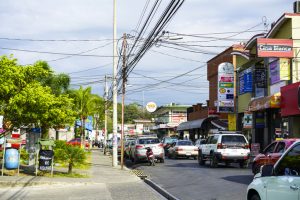 By Paul Wessel
By Paul Wessel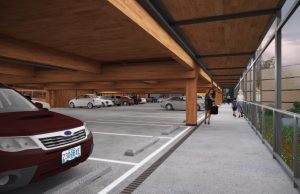


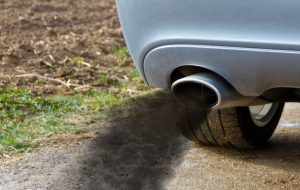 Drivers who park in London’s financial district may look to use transit or upgrade older vehicles thanks to a new regulation that has drivers of high-emitting vehicles paying an extra tax to park.
Drivers who park in London’s financial district may look to use transit or upgrade older vehicles thanks to a new regulation that has drivers of high-emitting vehicles paying an extra tax to park.